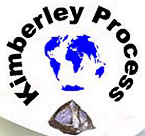 The decision by the Kimberley Process to readmit Zimbabwe into the Process and thereby allow exports from Zimbabwe’s Marange Field highlights the benefits and vulnerabilities of a sincere effort to eliminate blood diamonds from the international marketplace.
The decision by the Kimberley Process to readmit Zimbabwe into the Process and thereby allow exports from Zimbabwe’s Marange Field highlights the benefits and vulnerabilities of a sincere effort to eliminate blood diamonds from the international marketplace.
As pearl and bead stringers, the Kimberley Process may seem somewhat remote. However, as members of the trade we have a responsibility to informed on major issues affecting it. Moreover, clients will ask about blood diamonds or the Kimberley Process and it’s important to be able to answer them knowledgeably. Most directly, some of us use diamond beads in our work.
For two years the Kimberley Process has attempted to block exports of Marange Region diamonds to the world market.
When the vast alluvial deposits were found in the Marange Region a few years ago, the government of Robert Mugabe moved quickly to seize the field. It ousted the British owner of the mineral rights and seized the company’s equipment. It then moved to eliminate local people mining the field by brutally killing them and torturing those it didn’t kill.
Then, to retain the loyalty of the army, Mugabe allowed various army units to rotate through the region with results that you can imagine for the local populace. (Remember, too, these diamond deposits are alluvial, meaning they are at or near the surface. Mugabe’s effort to pay off the military with access to alluvial deposits meant little new investment on their part.) This is in addition to the creation of state owned mining companies funneling revenue directly to Mugabe and his family.
The abuses were clear, documented and incontestable and in 2009, the Kimberly Process moved to block diamond exports from Zimbabwe.
What followed was a circus.
- Critics said that the diamonds weren’t really “blood” diamonds. Blood diamonds are those which are used to finance rebel groups against a legitimate government. This is not and has never been the case in Zimbabwe despite the clear human rights violations.
- The Zimbabwe government pointed to Improvements in the mining conditions in the Marange Region although there was and apparently still is violence in the region.
- The Zimbabwe government and other African countries called the process racist and refused to recognize the Kimberley process at all, insisting it was defunct.
- Marange diamonds made their way into the world market without the KP certification.
- Non-governmental organizations, including human rights organizations, threatened to walk out of the Kimberley Process and in fact did boycott the meeting which green lighted sales of the diamonds.
The net result: Not much change in Zimbabwe mining practices and a serious weakening of the credibility of the Kimberley Process. Most observers agree in fact that the decision to allow KP certified sales of Zimbabwe diamonds was simply an effort by the KP to “get past” the issue and salvage the Process.
It’s also important to remember that the Zimbabwe deposits are huge, they could account for 25% of the world diamond market, according to some observers. But the deposits are alluvial, meaning that when they’re mined out, they’re gone. So, while the government of Zimbabwe funnels money into its pockets, the people of Zimbabwe who could benefit from this resource have been the loser. Will the new accord change this? Dubious.
KP Strengths and Weaknesses
The major weakness of the Kimberley Process is that not only is it voluntary, its concern is with the internal issues of a country. While governments can initiate changes internally, it’s difficult for outsiders to initiate internal change in other countries. They resent and resist it, as Zimbabwe did.
The strength of the Kimberley Process is that it can and does draw attention to human rights abuses. Non-governmental organizations, in particular, can marshal publicity about the abuses, drawing consumer attention to the issue.
Various reports in the trade suggest the diamond industry is divided about continued support of the Kimberley Process in the wake of what is an uncontroverted debacle. And, it’s difficult to point to solutions going forward. How does the most well meaning organization intervene effectively in the internal affairs of a sovereign nation?
Nevertheless, the Kimberley Process has made real strides in highlighting human rights abuses and has been a credible vehicle for educating the public about these very important issues.
and

